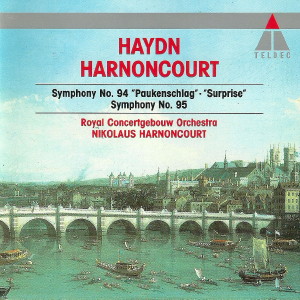 |
1 CD -
9031-73148-2 - (p) 1991
|
|
| Franz Joseph
Haydn (1732-1809) |
|
|
|
|
|
|
|
| Symphony Nr. 94 in G major,
Hob. I/94 "Mit dem Paukenschlag" |
|
23' 08" |
|
| - Adagio cantabile - Vivace
assai |
9' 29" |
|
1
|
- Andante
|
6' 00" |
|
2
|
- Menuett - Trio
|
3' 47" |
|
3
|
| - Finale |
3' 52" |
|
4
|
| Symphony
Nr. 95 in C minor, Hob. I/95 |
|
19' 45" |
|
| - Allegro |
6' 43" |
|
5
|
| - Andante |
4' 23" |
|
6
|
| - Menuetto - Trio |
4' 50" |
|
7
|
- Finale : Vivace
|
3' 59" |
|
8
|
|
|
|
|
| ROYAL CONCERTGEBOUW
ORCHESTRA AMSTERDAM |
|
| Nikolaus
Harnoncourt, Dirigent |
|
|
Luogo
e data di registrazione
|
| Concertgebouw,
Amsterdam (Olanda) - febbraio 1990 |
|
Registrazione
live / studio
|
| studio |
Producer
/ Engineer
|
Wolfgang
Mohr / Helmut A. Mühle / Michael Brammann
|
Prima Edizione CD
|
| Teldec
- 9031-73148-2 - (1 cd) - 43' 23" - (p)
1991 - DDD |
|
Prima
Edizione LP
|
-
|
|
|
Notes
|
“As the head of an
orchestra I was able to experiment, to
observe what produces a particular
impression and what detracts from lt,
i.e. to improve, make cuts, add
things, take risks. I
was cut off from the outside world.
There was no-one around to plague and
harrass me, and so I
had to be original.” In
describing the conditions under which
he worked at the court of Prince
Nikolaus I. of Esterházy
thus, Joseph Haydn unknowingly laid
the foundations for nearly two hundred
years of misinterpretations of both
his personality and his music. His
contemporaries, it's true,
acknowledged him as the leading
composer of his time, but Haydn’s
reputation faded soon after his death.
And it was all too rapidly forgotten
in the process that this much-abused
composer was actually one of the prime
movers in the transition from the
pre~Classical to the Classical period
in music history. The influence of the
so-called Mannheim School led by
Johann Stamitz, Franz Xaver Richter
and Ignaz Holzbauer
remains not undisputed to the present
day. but there can be little doubt
that Haydn incorporated into his later
works in particular those new features
that pointed the way fonward to the
Classical era and indeed to Romantic
music 1: “...the way
that combined the rational
craftsmanship of older
music with the new irrationalism of
the emotions” (Rummenhöller).
Later generations found depth of
emotion lacking here (the Romantics),
or Classical simplicity (the
Neo-Classicists), forgetting that the
conquest of new realms of expression
never starts with the perfection of
the utmost mastery, but approaches
this ideal hesitantly.
An era that made the
echo of revolutionary thinking or
action, or the personal experience of
social alienation, into the criterion
for judging music
critically was obviously going to take
a dim view of the relatively secure
existence of a composer like Haydn.
The very number of symphonies Haydn
completed - a total of 104
(Mandyczewski) - was
sufficient to pass musicological
sentence in a time when a Ninth
Symphony represented the climax of a
composers śuvre.
It took a long time
before people realised the
significance of Haydn’s rejection
of the material security offered by
the court of Naples in favour of an
uncertain future as a freelance
composer for Johann Peter Salomon’s
newly-founded subscription concerts’
in London. Free of all the constraints
and privileges of a court post, Haydn
faced the challenge of the `free
market’ for the first time. The twelve
"London Symphonies"
that he wrote in this period, 1791-95,
are both the climax
and the final flowering of his
symphonic śuvre:
the works in this cycle are marked by
consistent motif-work both in the
development and also in the exposition
and the reprise of the sonata form, by
thesis and antithesis in the thematic
treatment, and by the renunciation of
the Baroque form of the ornamental and
foundation parts in favour of equal
treatment of all the parts.
The two symphonies on this disc are
fruits of Haydn`s first visit to
London in 1791/92.
The English nickname given to no. 94,
“The Surprise", is actually far more
appropriate than its German sobriquet
"Drumbeat". It
remains an open question, whether
Haydn really wanted
to jolt
the gently dozing audience awake with
this drumbeat at the
beginning of the second movement; the
composer shows himself once again from
his light-hearted, ironic side here,
as in the Symphony no. 60 ‘Il
Distratto” or no. 83 "The Hen".
Symphony no. 95, on the other hand, is
the sole work of the
London series set in a minor key (C
minor).
Unlike Haydn's numerous "early"
symphonies, every generation of
interpreters has shown interest in the
composer's “London” works. In
the process, though, it
became almost a guiding principle that
Mozart had to sound like Beethoven,
and Beethoven like Bruckner. It
was left up to the present generation
to break away from this distorted view
of Haydn’s music. Today’s concert
programmes offer traditional, original
and mixed performances alongside each
other. The listener must decide for
himself whether the "Morning Herald"
review of l6th March
1792 still holds true:
"We have hardly ever experienced a
greater musical delight.
No fewer than six compositions
by Haydn were performed, displaying
a wealth and diversity of brilliant
inspiration that surpass all other
modern compositions by far."
Andreas
Kluge
Translation: Clive Williams
|
|
Nikolaus
Harnoncourt (1929-2016)
|

|

|
|